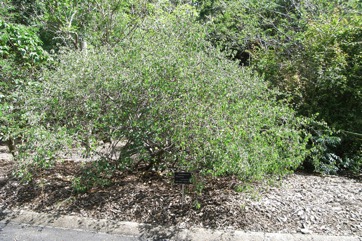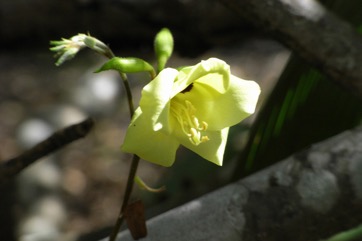St Thomas Tree, Yellow Bauhinia, Yellow tree bauhinia

A tropical plant. It grows at low altitude woodland and along rivers. It needs well drained soil. It can be in coastal dune bush. In East Africa it grows from sea level to 2,100 m above sea level. In XTBG Yunnan. It suits hardiness zones 10-12. In Brisbane Botanical gardens.
Also known as:
Adavimandaramu, Aptu, Bohinia kuning, Ching-kho-dok-lue-ang, Iruvaji, Kachnar, Kanjanam, Katondo-tondo, Kupu-kupu, Lahkyang, Mahahlega-wa, Micorra, Mong bo hoa chanh, Mong-bo vang, Muandia, Mucorra, Mulema, Murema, Musaponi, Phalgu, Pilo asundro, Pita kanchana, Tali kancu, Tapak kuda
Synonyms
- Alvesia bauhinioides Welw.
- Alvesia tomentosa (L.) Britton & Rose
- Bauhinia pubescens DC.
- Bauhinia tomentosa var. glabrata Hook.f.
- Bauhinia volkensii Taub.
- Bauhinia wituensis Harm
- Pauletia tomentosa (L.) A. Schmitz
Edible Portion
- Leaves, Seeds, Flowers
Where does St Thomas Tree grow?
Found in: Africa, Asia, Australia, Central Africa, China, Congo DR, Dominican Republic, East Africa, East Timor, Haiti, Hawaii, India, Indochina, Indonesia, Kenya, Malaysia, Mozambique, Myanmar, North America, Pacific, Pakistan, Papua New Guinea, PNG, Philippines, Sao Tome and Principe, SE Asia, Sri Lanka, Taiwan, Tanzania, Thailand, Timor-Leste, United States, Vietnam, West Africa, West Indies, Zambia, Zimbabwe
Notes: It is grown as an ornamental. There are about 250-350 Bauhinia species. Most are in the tropics. Also as Caesalpinaceae.
Status: It is not known if it is used for food in Papua New Guinea.
Growing St Thomas Tree, Yellow Bauhinia, Yellow tree bauhinia
Cultivation: Plants can be grown from seeds and also by grafting or air-layering.
Edible Uses: The young sour leaves are eaten with rice or added to soups. They are also used to flavour other foods. The seeds are also eaten. The flowers are boiled and eaten as a vegetable and used in stir fries.
Production: Plants grow quickly.
Nutrition Info
per 100g edible portion| Edible Part | Energy (kcal) | Protein (g) | Iron (mg) | Vitamin A (ug) | Vitamin c (mg) | Zinc (mg) | % Water |
|---|---|---|---|---|---|---|---|
| - | - | - | - | - | - |
St Thomas Tree, Yellow Bauhinia, Yellow tree bauhinia Photos



References
Ambasta S.P. (Ed.), 2000, The Useful Plants of India. CSIR India. p 69
Barwick, M., 2004, Tropical and Subtropical Trees. A Worldwide Encyclopedic Guide. Thames and Hudson p 49
Bircher, A. G. & Bircher, W. H., 2000, Encyclopedia of Fruit Trees and Edible Flowering Plants in Egypt and the Subtropics. AUC Press. p 55
Cundall, P., (ed.), 2004, Gardening Australia: flora: the gardener's bible. ABC Books. p 221
Dharani, N., 2002, Field Guide to common Trees & Shrubs of East Africa. Struik. p 199
Engel, D.H., & Phummai, S., 2000, A Field Guide to Tropical Plants of Asia. Timber Press. p 156
Etherington, K., & Imwold, D., (Eds), 2001, Botanica's Trees & Shrubs. The illustrated A-Z of over 8500 trees and shrubs. Random House, Australia. p 121
Facciola, S., 1998, Cornucopia 2: a Source Book of Edible Plants. Kampong Publications, p 66
Flora Zambesiaca. http://apps.kew.org/efloras
Fowler, D. G., 2007, Zambian Plants: Their Vernacular Names and Uses. Kew. p 28
Ghorbani, A., et al, 2012, A comparison of the wild food plant use knowledge of ethnic minorities in Naban River Watershed Nature Reserve, Yunnan, SW China. Journal of Ethnobiology and Ethnomedicine; 8:17
Hearne, D.A., & Rance, S.J., 1975, Trees for Darwin and Northern Australia. AGPS, Canberra p 31
Hedrick, U.P., 1919, (Ed.), Sturtevant's edible plants of the world. p 95
Hibbert, M., 2002, The Aussie Plant Finder 2002, Florilegium. p 39
Latham, P. & Mbuta, A. K., 2014, Useful Plants of Bas-Congo Province, Democratic Republic of Congo. Volume 1. Salvation Army. p 72
Llamas, K.A., 2003, Tropical Flowering Plants. Timber Press. p 198
Martin, F.W. & Ruberte, R.M., 1979, Edible Leaves of the Tropics. Antillian College Press, Mayaguez, Puerto Rico. p 198
Menninger, E.A., 1977, Edible Nuts of the World. Horticultural Books. Florida p 90
Ochse, J.J. et al, 1931, Vegetables of the Dutch East Indies. Asher reprint. p 369
Palgrave, K.C., 1996, Trees of Southern Africa. Struik Publishers. p 284
Peekel, P.G., 1984, (Translation E.E.Henty), Flora of the Bismarck Archipelago for Naturalists, Division of Botany, Lae, PNG. p 216. 217,
Peters, C. R., O'Brien, E. M., and Drummond, R.B., 1992, Edible Wild plants of Sub-saharan Africa. Kew. p 121
Pham-Hoang Ho, 1999, An Illustrated Flora of Vietnam. Nha Xuat Ban Tre. p 855
Plants of Haiti Smithsonian Institute http://botany.si.edu/antilles/West Indies
Recher, P, 2001, Fruit Spirit Botanical Gardens Plant Index. www.nrg.com.au/~recher/ seedlist.html p 4
Scudder, 1962, 1971,
Sp. pl. 1:375. 1753
Staples, G.W. and Herbst, D.R., 2005, A tropical Garden Flora. Bishop Museum Press, Honolulu, Hawaii. p 306
Sukarya, D. G., (Ed.) 2013, 3,500 Plant Species of the Botanic Gardens of Indonesia. LIPI p 588
Terra, G.J.A., 1973, Tropical Vegetables. Communication 54e Royal Tropical Institute, Amsterdam, p 29
Verdcourt, B., 1979, Manual of New Guinea Legumes. Botany Bulletin No 11, Division of Botany, Lae, Papua New Guinea. p 118
World Checklist of Useful Plant Species 2020. Royal Botanic Gardens, Kew